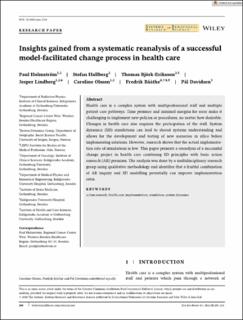| dc.contributor.author | Holmström, Paul | |
| dc.contributor.author | Hallberg, Stefan | |
| dc.contributor.author | Björk-Eriksson, Thomas | |
| dc.contributor.author | Lindberg, Jesper | |
| dc.contributor.author | Olsson, Caroline | |
| dc.contributor.author | Bååthe, Fredrik | |
| dc.contributor.author | Davidsen, Pål | |
| dc.date.accessioned | 2021-07-28T08:34:46Z | |
| dc.date.available | 2021-07-28T08:34:46Z | |
| dc.date.created | 2020-09-14T12:33:04Z | |
| dc.date.issued | 2020-07-20 | |
| dc.identifier.issn | 1092-7026 | |
| dc.identifier.uri | https://hdl.handle.net/11250/2765490 | |
| dc.description.abstract | Health care is a complex system with multiprofessional staff and multiple patient care pathways. Time pressure and minimal margins for error make it challenging to implement new policies or procedures, no matter how desirable. Changes in health care also requires the participation of the staff. System dynamics (SD) simulations can lead to shared systems understanding and allows for the development and testing of new scenarios in silico before implementing solutions. However, research shows that the actual implementation rate of simulations is low. This paper presents a reanalysis of a successful change project in health care combining SD principles with basic action research (AR) premises. The analysis was done by a multidisciplinary research group using qualitative methodology and identifies that a fruitful combination of AR inquiry and SD modelling potentially can improve implementation rates. | en_US |
| dc.language.iso | eng | en_US |
| dc.publisher | Wiley | en_US |
| dc.rights | Navngivelse 4.0 Internasjonal | * |
| dc.rights.uri | http://creativecommons.org/licenses/by/4.0/deed.no | * |
| dc.title | Insights gained from a systematic reanalysis of a successful model-facilitated change process in health care | en_US |
| dc.type | Journal article | en_US |
| dc.type | Peer reviewed | en_US |
| dc.description.version | publishedVersion | en_US |
| dc.rights.holder | Copyright 2020 The Authors | en_US |
| cristin.ispublished | true | |
| cristin.fulltext | original | |
| cristin.qualitycode | 1 | |
| dc.identifier.doi | 10.1002/sres.2724 | |
| dc.identifier.cristin | 1829682 | |
| dc.source.journal | Systems research and behavioral science | en_US |
| dc.source.pagenumber | 204-214 | en_US |
| dc.identifier.citation | Systems research and behavioral science. 2020, 38 (2), 204-214 | en_US |
| dc.source.volume | 38 | en_US |
| dc.source.issue | 2 | en_US |

